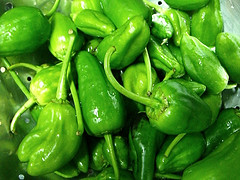On my last trip to Barcelona a couple of months ago, My good friend Gabriella who is always in the mood for good food and wine, joined me for a self-guided tapas tour one warm Saturday evening. After we got sidetracked at some fun shops on the Rambla de Catalunya and the Passeig de Gracia, we stopped at Cerveceria Catalana. If you are new to the idea of tapas and don’t mind being with others who are too, this is a great place to start. Its big, there is plenty of seating (not always common in tapas places) and it has great food, menus in English, many traditional options some with a modern flair, and great service! I was skeptical as I knew this place might be touristy but I was pleasantly surprised by the food and won over by the friendly staff.
Our next stop was pure fun. I had heard of Tapaç 24 as it is overseen by Chef Carles Abellan from Comerç 24 and I was looking forward to trying some of his inventive cuisine. Sitting on high stools, surrounded by colourful painted walls and fresh vegetables hanging between the bar and the glass through which we could watch the chefs at work, we were not disappointed. Practically everything on the menu is based on traditional Catalan dishes and ingredients, some with inventive twists, and everything made with the best fresh ingredients. We started with the Tapa D’Or – or Golden tapa for 2.50€ which was a plate of quality extra virgin olive oil with tomatoes served with crusty country bread. Next we ordered the restaurants version of Bombes called Bombes de La Barceloneta for 3.50€. Bombes are a type of croquette, always round. Our other tapa was the Tapas 24 version of the Catalan “Coca” which is like a pizza topped with fresh vegetable goodness with some caviar sprinkled on for fun. We of course enjoyed our tapas with some local sparkling cava and vowed to return someday soon!
Soon we were off again. To reach our third destination we took a 10 or 15 minute stroll down to the Born area near the Picasso Museum and stopped in at a packed Basque pintxos bar called Euskal Etxea, or the Basque house. Not just a source of great pintxos the Euskal Etxea is also a sort of Basque cultural center which offers activities and basque language classes. We stood at the bar and as is the custom here, were offered a plate and allowed to take what we wanted from the heaping plates of pintxos and kept our toothpicks in good faith in order to pay at the end. A weeknight might be better to stop here as it gets pretty crowded but no one really seemed to mind, and since this is the norm here in Spain, we were quite happy to enjoy our txacoli and pintxos elbow to elbow with our fellow diners.
The details.
Cerveceria Catalana
C/ Mallorca, 236. Between Rambla de Catalunya and Balmes.
93 216 03 68
Tapaç 24
Carrer Diputacio, 269 (just east of Passeig de Gracia)
Euskal Etxea
C/ Montcada 1-3, Barcelona 08003 (next to the Picasso Museum)





























